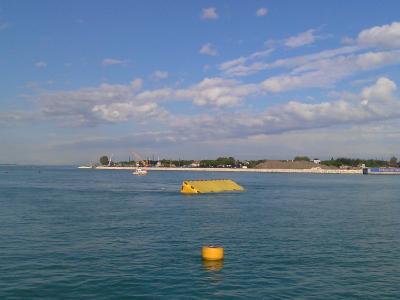Venice flood barriers pass first test
ANDREW GARGANO
|
14 October 2013

The first gate of the Mose system rises from the water
VENICE - The MOSE project successfully launched its first test last weekend after four flood barriers rose from the water to demonstrate how the system will protect Venice from flooding. The €5.4 billion "made in Italy" project, managed by the Consorzio Venezia Nuova, is nearly 80 percent complete and will allow Venice to combat high tides and rising sea levels.
Venice has been facing the challenge of rising waters for many decades now. In 1966, the city was covered by one metre of water, and since that time, the city continues to flood several times each year. The city is also slowly sinking by several millimetres annually. The fragile condition of Venice has prompted the attention of public figures who have searched for solutions to keep the city alive and afloat for years. In 1987, the Consorzio Venezia Nuova and the Italian Ministry of Infrastructure commenced operations for the Experimental Electromechanical Module, now referred to as MOSE. The construction of the floodgate system began in 2003.
After ten years of work, the project was finally ready to be tested last weekend. The Consorzio Venezia Nuova hosted a group of well over 100 journalists to cover the special event and invited them aboard the company boat to watch the first official test of the floodgate mechanisms. The group was joined by dozens of company and public officials, including the Italian Transport Minister, Maurizio Lupi, the Governor of Veneto, Luca Zaia, and the Mayor of Venice, Giorgio Orsoni.
Shortly after 3 pm, the group watched as one of the 300 tonne gates rose from the water. Three more gates followed, one by one creating a small barrier between the lagoon and the Adriatic Sea. The test was successful and Mayor Orsoni called the demonstration an "important moment for the city."
In total, there will be 78 floodgates that comprise the MOSE system. The gates are contained in tanks on the sea floor, located along three different inlets into the lagoon: Lido, Malamocco, and Chioggia. The barriers will offer protection from high tides of up to three metres and will protect the seaside cities of Venice, Mestre, and Chioggia. When the tidal water reaches 1.1 metres above its normal level, the system will be activated, pumping air into the barriers and causing them to rise. However, if the water level does not exceed 1.1 metres, then the system will not be activated. Hermes Redi, Consorzio Venezia Nuova's General Director, stated that "these locks will not defend Venice from all high water," and that the cities inside the lagoon will only be protected from serious flooding. Signor Redi also noted that the system will only be able to operate up to seven times each year.
The MOSE system is making an important impact on the Venice area not only because it will help save the city from becoming submerged, but also because it has helped to stimulate the region's economy. 50 companies have been involved in the massive project overseen by the Consorzio Venezia Nuova and the project has brought over four thousand jobs to the Venice area. The project is "a driving force for the Veneto economy," said Governor Luca Zaia.
The project has however faced a great deal of criticism and many impediments over the years. The project was delayed several times due to economic crises, and it has also been plagued by scandal. In July, 14 people were arrested after an investigation found corruption prevalent inside the project: officials were securing lucrative deals with certain companies. The former head of the project, Giovanni Mazzacurati, was among those arrested. Roughly 100 others were placed under official investigation.
Many critics have argued that the project will have serious consequences on the environment. Alberto Scotti, designer of the MOSE system, has asserted that MOSE will have "no permanent effects on the lagoon." He stated that the project "cannot have negative effects on the morphology, nor on the quality of the water, nor the port system." While the project strives to prevent these negative impacts from occurring, the work underwater has certainly disrupted the natural habitats of existing wildlife to at least a small extent.
Currently the project is estimated to be completed by the end of 2016. When the project is finished, the 78 floodgates will form a barrier, blocking the three inlets from high tides and rising seas up to seven times each year.


